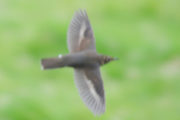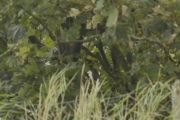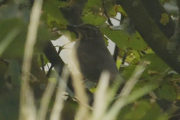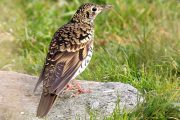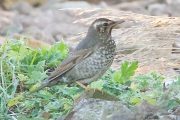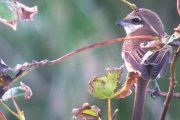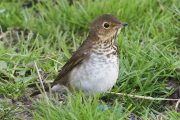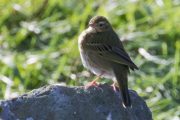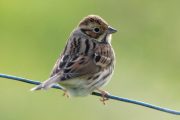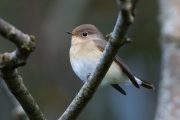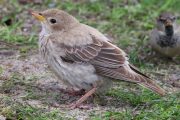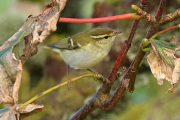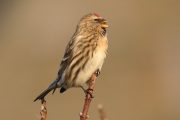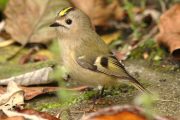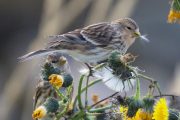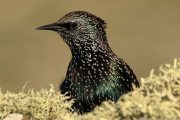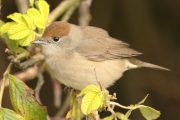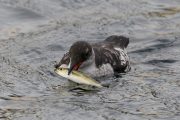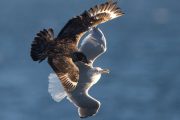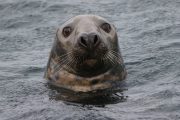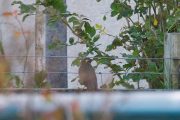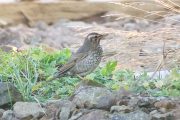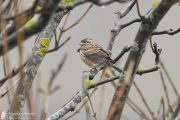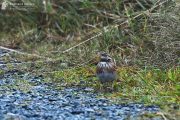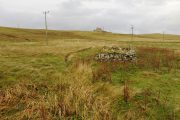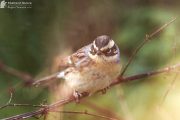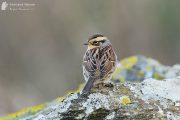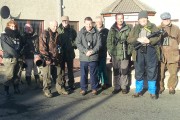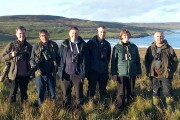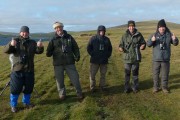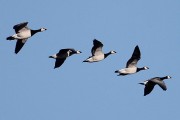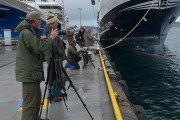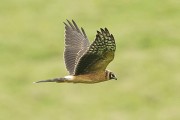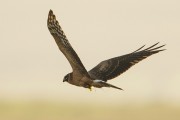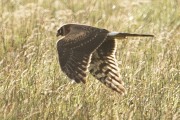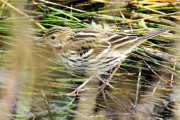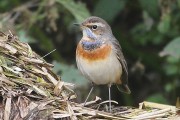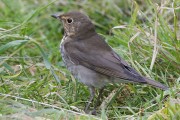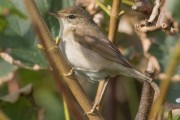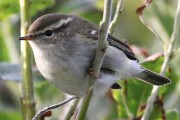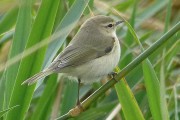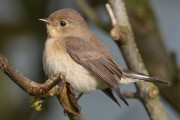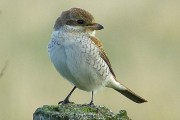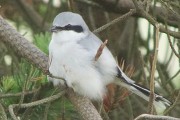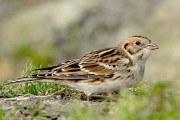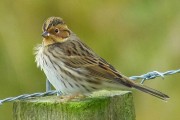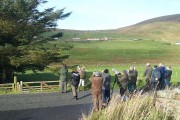Archive for the ‘Birding in Shetland’ Category:
Season’s Greetings from Shetland Nature
Posted by Brydon Thomason on Friday 24th December 2021 | Birding in Shetland
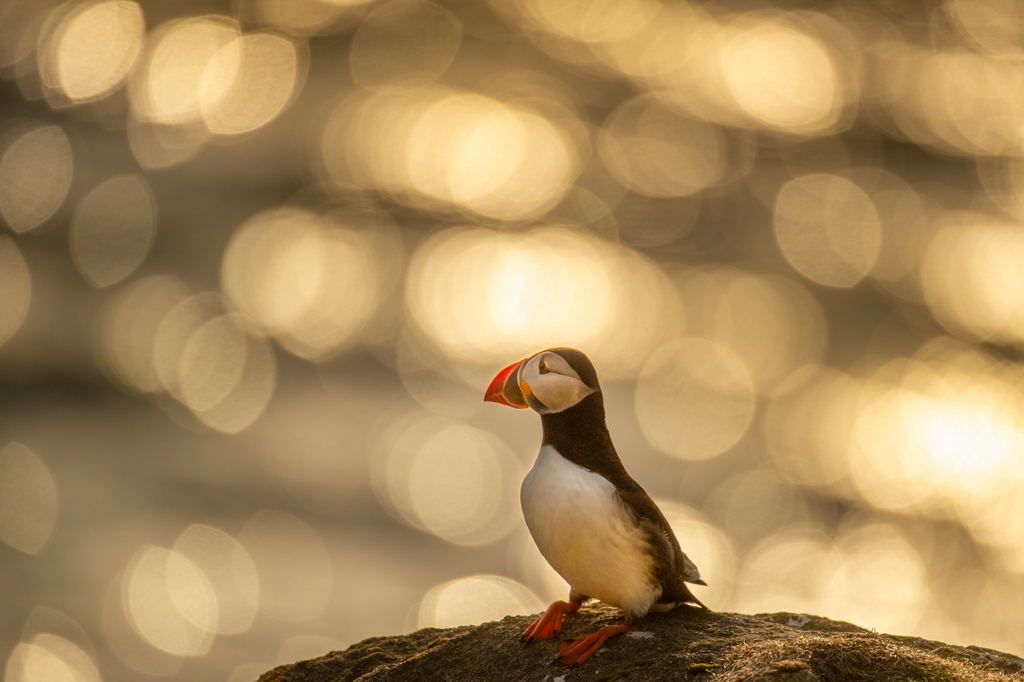
A Hermaness Puffin summer sunset, perhaps not the most festive of images, but the closest one I had to fairy lights!
Wishing you a Merry Christmas and a Happy New Year.
Along with our season’s greetings, we wish you as happy and healthy a Christmas as the ever-changing pandemic allows.
Briefly reflecting on our season, although there were understandable and expected challenges and changes, we had a very busy and exciting season. True to form, our islands provided a plethora of wildlife highlights, from the usual suspects through our magnificent summer breeding birds and marine life, to the unexpected and exotic- a Beluga Whale and a Walrus! Sharing these again, felt so very special.
It feels appropriate to say here that in early spring, being extra cautious and mindful to protect our clients and communities, and following local transport authority guidance at that time, we made the difficult decision to postpone all our multi-household group holidays, but continue with day tours and bespoke holidays. Hard as that was, knowing of tour companies who had to cut short holidays and isolate participants due to positive cases, we feel that decision was the right one.
We are so grateful to all those who were able to postpone and so understanding in doing so.
Looking ahead to 2022 and continually following guidelines to keep our clients and communities safe, we are feeling optimistic and excited about next summer. Amongst new plans and ventures we are planning, we are very excited to have recently announced a new date for our collaboration with Kate Humble, on our Wild and Wooly itinerary.
We have filled all but one or two spaces across our holiday itineraries next season. Please note across these itineraries we are making some amendments due to accommodation changes, which will be updated soon.
We are also pleased to see an increase in people wanting a tailored and bespoke holiday.
Please do get in touch if you think we can help.
With the very best festive wishes,
Brydon Thomason and all at Shetland Nature.
Permalink
White-winged Scoter
Posted by Brydon Thomason on Friday 24th November 2017 | Birding in Shetland, Brydon's Shetland Nature Blog
On Wednesday 18th October Dougie Preston found a Ring-necked Duck on Sand Water, near Gutcher on Yell. A first for the island and Shetlands second in a week- this was in itself a worthy discovery. It was whilst photographing it however that his day was about to get even better. With the RND framed up in his viewfinder, an immature/female type Velvet Scoter shot through his field of view as it landed on the loch alongside the small flock of aythya ducks.
Instinctively he fired off a few frames, then almost immediately it started to dive. Barely two minutes later, at approximately 13:20pm the duck took flight, heading north in the direction of Gutcher and the Bluemull Sound area. He was immediately struck by its atypical head shape and bill profile, especially the latter which set alarm bells off as his as his mind’s eye recalled Birding Frontiers articles on White-winged Scoter! A very commendable shout indeed.
After consulting available literature on WWS Dougie posted a photo on the local WhatsApp group at 14:24pm which read; “Comments welcome… Only touched down very briefly on Sand Water Yell early afternoon“.
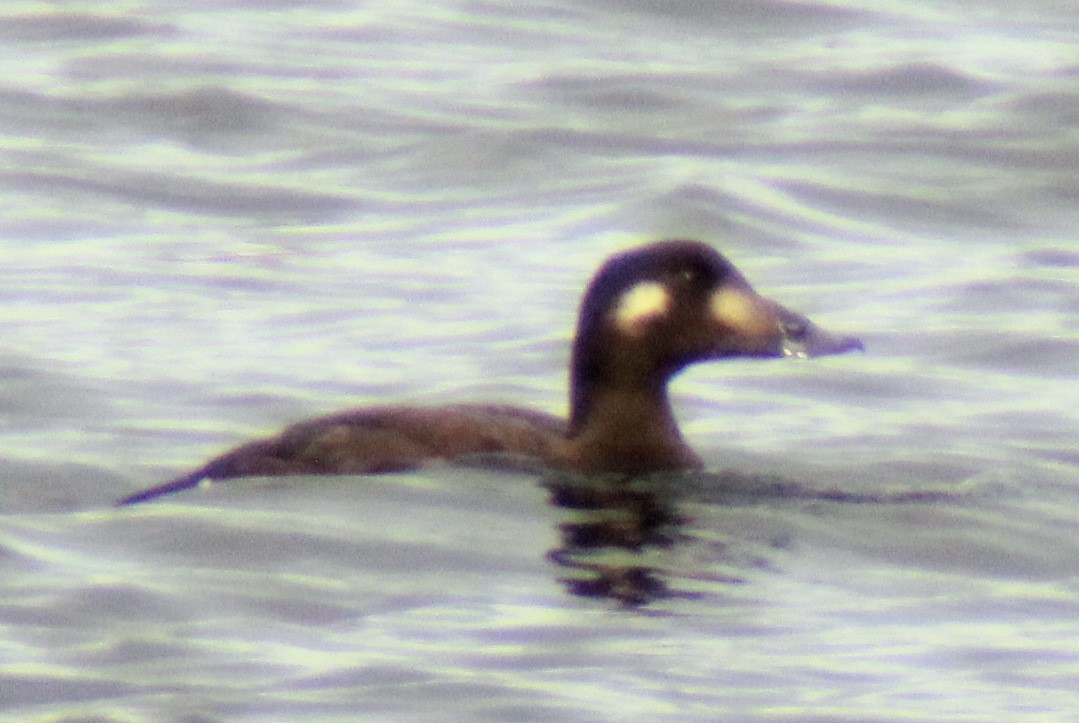
The image that got the ball rolling: White-winged Scoter, Sand Loch, Yell, 18 October 2017 (Dougie Preston).
Prior to this and completely unaware of the goings on, I was birding the Belmont Farm area, (having dropped off tour guests at the ferry) when I found a female/immature type Velvet Scoter at approximately 14:15pm on Loch of Belmont. With ‘bins only’ views and at quite a distance from the farm yard I hadn’t much to go on however was intrigued enough to want it in the scope. Velvet Scoter is a scarce enough bird in Shetland that any rarity savvy birder should always want scope views.
Returning to the car at far side of the farm I drove back through the yard in the hope of getting it in the scope however it and the Long-tailed Ducks it had been loosely associating with had gone. A scan of the ferry terminal and closest loch, Snaravoe drew a blank. It wasn’t until back in signal an hour later in Uyeasound that I picked up Dougie’s WhatsApp messages which had certainly sparked interest to say the least. Paul Harvey had been quick off the mark with positive feedback to Dougie’s post and had also contacted him directly to discuss the bird.
I was only five minutes away birding Uyeasound so hurried back, my heart racing as I thought it must surely be the same bird. It had returned to Loch of Belmont and now with scope views and a few hand held, shaky ‘iphone-scoped’ images I could see enough to see the same ‘Surf Scoter like’ appearance with square head shape and flat crown; raised bill profile and ‘broken nosed’ look.
With no signal I had to race down to the ferry terminal for WiFi to call for back-up from fellow Unst birders. I couldn’t get through to Micky Maher however Mike Pennington had already acted on intuition, knowing that Sand Water was just a few miles away (only 2.5 he later found out!), hoping to relocate the scoter and was literally just a few hundred yards up the road scanning Loch of Snaravoe.
Although the light conditions and distance from the bird were far from ideal Mike was keen on its ‘putative’ identity as was Micky Maher who arrived armed with various Birding Frontiers literature on White-winged Scoter identification. As we discussed the bird we shared thoughts and memories of our hugely missed friend Martin Garner, the ‘Birding Frontier’ himself and how he would have loved this bird. He would have been our first call and now always the first thought in such challenging ID’s.
Dave Cooper and Alan Conlin were not too far behind, each also arriving with the same articles in hand – the favoured being Guillermo Rodriguez Lazaro’s article on Birding Frontiers website which we found invaluable.
This was a peculiar situation for us in that although Dougie had already found and flagged it up, with only two previous British records and in a plumage not yet recorded in Europe, this still felt a difficult call to make.
It was now well after 16:00pm and light was poor but with dusk also approaching conditions were challenging, to say the least. It was increasingly harder to assess and be sure of features we thought we could see. At this stage however we were confident that based on its distinctive overall ‘Surf Scoter like’ head shape and appearance and especially bill structure, profile and length that this bird surely could not be a fusca– or at least was not like any we had ever seen but it was a very good fit for deglandi, having also considered Stejnegeri.
In addition to the above we were also struck by the size and position of the large oval shaped nostril, (we all commented that you could see straight through it) and now ‘genned-up’ on finer ID points on the bill feathering-pattern and angle, we knew what to look for. The latter looked to be a good fit and certainly did appear to extend beyond the nostril and more importantly formed a 90-degree angle. However in the difficult light conditions and distance this was not easy to assess with certainty and the unfortunate reality was that we just ran out of light and therefore time!
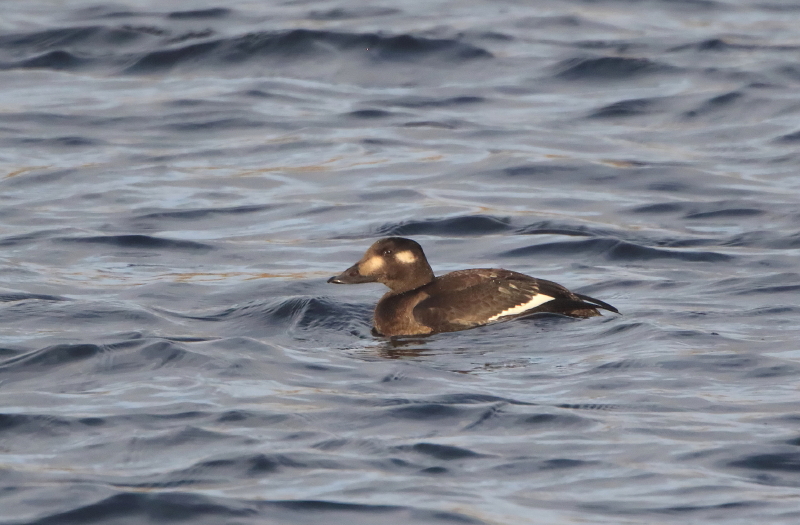
American White-winged Scoter, Loch of Belmont, Unst, 19 October 2017 (Robbie Brookes).
We decided on a cautious approach. It was agreed that further research of both Velvet and White-winged Scoter was needed and better still- closer views in the morning! We had also considered that realistically with ferry times no one would have been able to make it before dusk and after all news was already out on it.
We discussed the bird at length over the evening and put news out that it had been relocated on Loch of Belmont. I also spoke to Dougie who was naturally delighted that it had been relocated and to hear our opinion, very much in agreement with his. Of course this is said after just about every big birds identification but in hindsight we had enough at that stage for a conclusive identification that afternoon, especially with Dougie’s photograph and our field observations as well as supporting phone-scoped images.
With the chance to divulge and reflect confidence continued to grow later in the evening. Interestingly Margaret Pennington (Mike’s wife), pointed out a distinguishing feature that confirmed for certain they were the same bird. It was a small white smudge on the bill bellow its right hand nostril, which was consistent on all images.
Unfortunately Dougie had commitments the following morning so couldn’t be there with me at first light but thankfully it was still present. Mike and Dave arrived soon after and at last with better views there was a much more relaxed vibe as we watched the bird- helped eventually by shared opinion from Paul Harvey and Roger Riddington, who were amongst the first to arrive. They too agreed how subtle it was and how that in different circumstances it might have been overlooked but especially how well Dougie had done initially.
Needless to say it was quite the performer that morning! This was quite the opposite to our first encounter, allowing for really good images to be nailed which 100% confirmed the key features we’d tentatively noted, leaving many to have probably thought- oh yes, surely that was never a Velvet- it’s obviously a White-winged Scoter!!
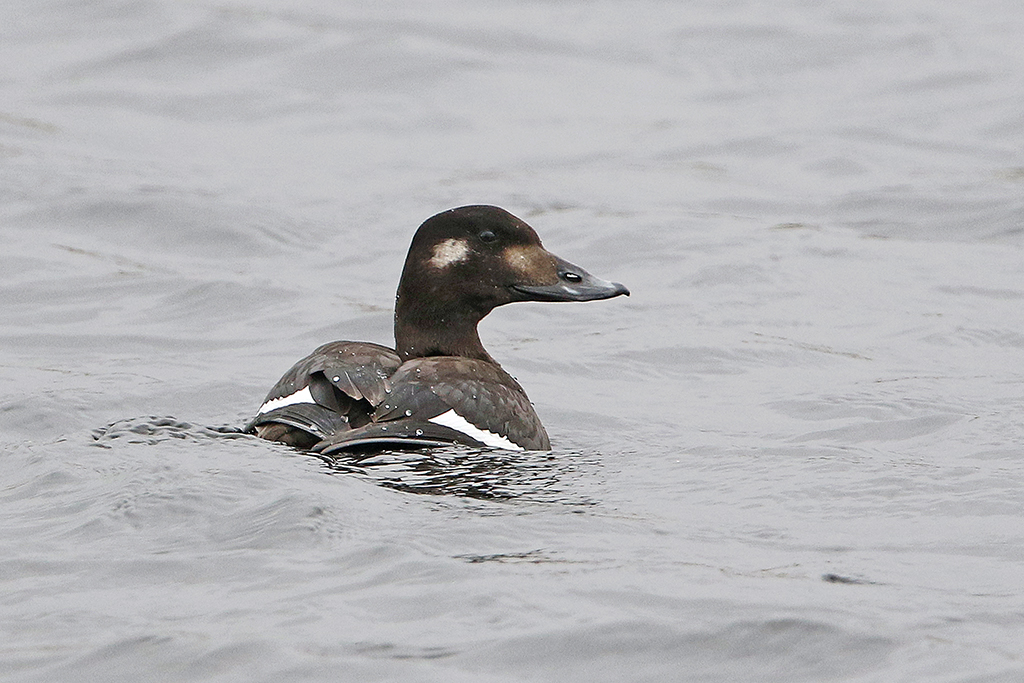
The American White-winged Scoter performed much closer on the morning of 19 October and allowed for excellent images to be taken, documenting the identification beyond all doubt. The distinctive head and bill structure are particularly apparent in this photo (Jim Nicolson).
Recently I contacted Guillermo Rodriguez asking him for comment and if we were right in thinking it was a 1st winter male. He responded:
“Hi Brydon, I fully agree with your diagnosis – the bird is a first-year male White-winged Scoter. Key features for ageing are the neat, homogeneous plumage, and velvet-like feathering around the bill, all certainly pointing towards a juvenile; sexing is slightly more complicated as this bird isn’t particularly short/long billed, but the relatively squared head and bumpy bill, and presence of significantly large white spots on the GC tips, all support sexing as male.
I’m leaving now for a trip so don’t have time to look for the originals – just take the pics you want from my post. And I agree Martin would have been super excited about this bird!
Best,
Guillermo”
Guillermo kindly allowed us to reproduce his composite of first-winter drake American White-winged Scoter images below, alongside an excellent image of a first-winter drake Velvet Scoter, taken in Shropshire in November 2016 by Dave Tromans. We believe these help to illustrate and compare the key features of fusca and deglandi, which were key to the identification of the Unst bird.
- Head shape tends to be more rounded in fusca, whereas deglandi shows a flatter crown and squarer, more Surf Scoter-like, appearance.
- The bill profile in fusca shows a distinct gentle concave profile, scooping downward from forecrown to bill tip, whereas deglandi shows a distinctively convex profile, creating a ‘broken-nosed’ appearance to the upperside. The bill was therefore deeper at the base, appearing to start from higher up on the forehead.
- In fusca the bill feathering stops before the position of the nostril and slopes back towards gape at about 40-degree angle, whereas in deglandi the feathering extends further, reaching below the nostril and forming a 90-degree angle. This is a feature that, although we were quite sure we could see, we found hard to assess at first. Closer views and images made this much easier.
- The nostril size and shape was quite striking; deglandi shows a larger and more oval-shaped nostril which, on the Unst bird, you could see right through, even at a distance, when the bill was in profile. This is in comparison to fusca, where the nostril is smaller and more rounded.
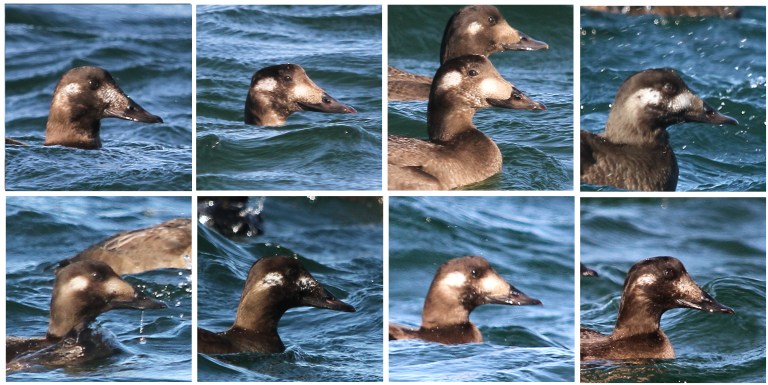
First-winter drake American White-winged Scoters, Crane Beach, Massachusetts, November 2016 (Guillermo Rodriguez).
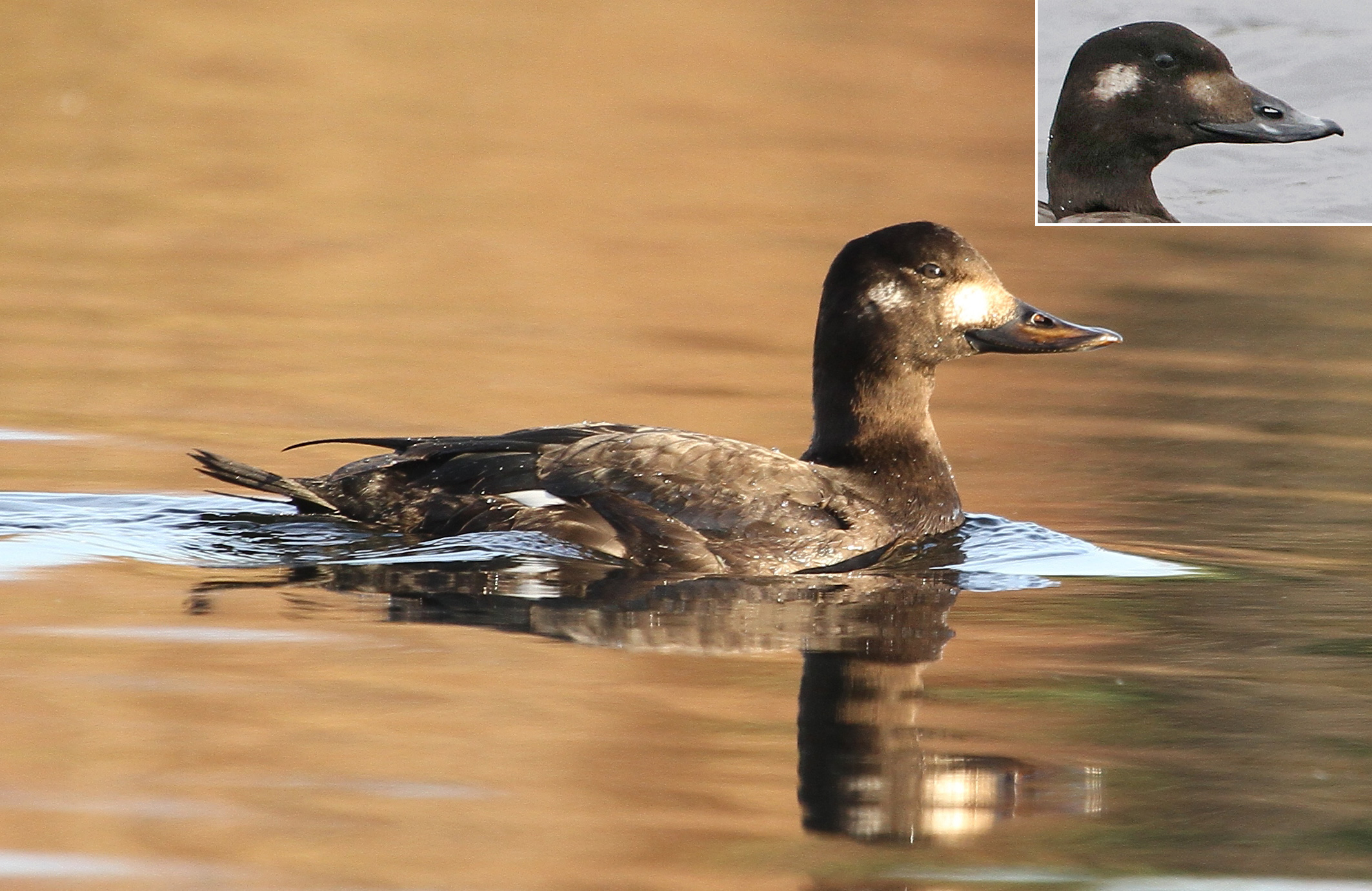
First-winter drake Velvet Scoter, Telford, Shropshire, November 2016 (Dave Tromans) with the Unst American White-winged Scoter for comparison.
Having fantasized about finding White-winged Scoter in Shetland this was a real privilege to have been part of this amazing bird and team effort, heralded by an impressive bit of impulse ID by Dougie. It was rather amusing that barely a week prior to this I found a juvenile Surf Scoter off Unst and on Twitter I joked that; “it was the third species of American duck on Unst in as many weeks- let’s hope the next one has white in its wings!”. Prior to the Surfie the island had already hosted Ring-necked Duck and American Wigeon.
It is perhaps relevant to add that it was later to transpire that this bird had been identified and actually photographed as a Velvet Scoter off Belmont just a few days before.
Hopefully this bird may serve to encourage/remind birders to scrutinise all ages and sexes of all Velvets, when possible. Having not been seen here since the 22nd of October, might this bird turn up again in a scoter flock somewhere in the country or even perhaps Europe?
Permalink
The Siberian Thrush, Baltasound, Unst, September 2017
Posted by Brydon Thomason on Monday 25th September 2017 | Birding in Shetland, Brydon's Shetland Nature Blog
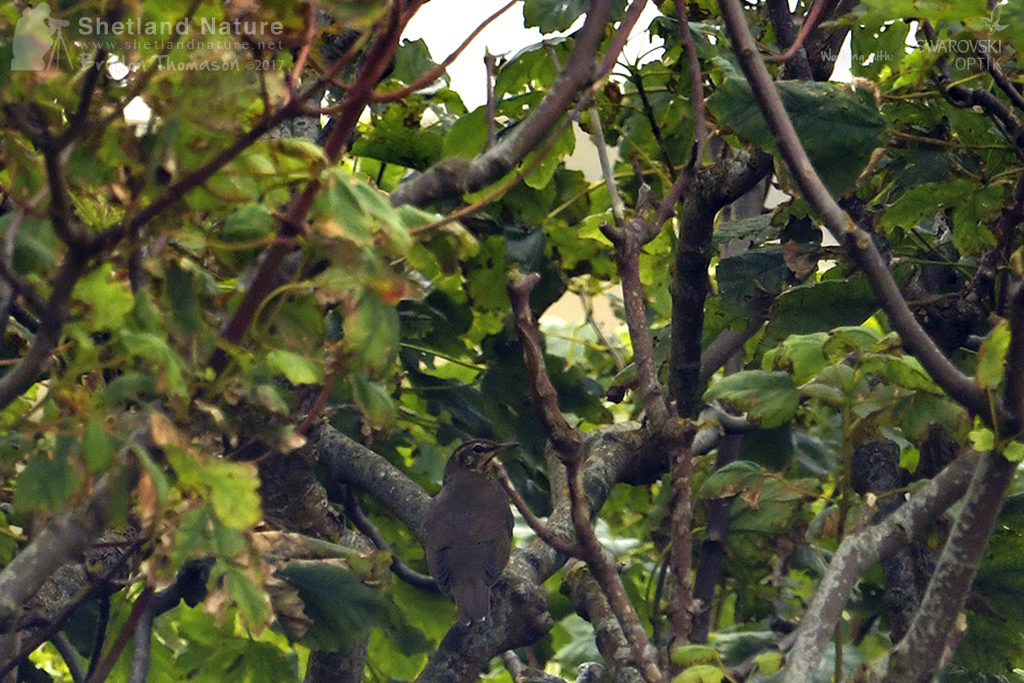
I opened our front room curtains about 07:30am. I’d been slow to get up due to your daughter Nula (15 months) having a restless night’s sleep, resulting in me having none! Two Yellow-browed Warblers chasing each other round the trees however was enough to get me fired- I grabbed my bins and set off for my morning circuit next door in Halligarth. The previous fall of Yellow-brows had been cleared out for a couple of days so clearly there were new arrivals. A third followed by two Willow Warbler and two Garden Warbler was enough to prompt a text to Roger Riddington; ‘New birds in!’, I wrote excitedly.
It was one of those flat calm mornings that just feels ‘rare’, that indescribable autumn atmosphere when you feel a monster rare is possible. The above tally was enough to convince me to carry on for an hour after breakfast and putting bairns to school. 12 Yellow-brows and an hour later, it was time to head home- I had work to do preparing for starting ground works with digger arriving next day.
A quick jaunt across Baltasound to borrow a ‘pinch bar’ (for lifting paving slabs), from Robbie Brookes was in order and on route yet more YBW’s caught my eye along the Ordaal road. Two feisty ‘Sibeie’ sprites were chasing each other round a roadside garden, visible from the car so I stopped and pulled over. Id tried earlier, with zero success to photograph one so I thought I’d try again, with a cheeky of the gardens too!
Standing outside the garden on the roadside, I’d been mimicking their sweet little call and probably doing a pretty poor job, but they’d posed nicely. A few frames in the bag, feeling mildly pleased at my efforts a bird flew up from just a couple of feet from me, out of base of hedge, flying straight across garden away from me and landing in a Sycamore only 30-40ft away.
As is often the way, it could only have been a three or four seconds glimpse as it flew across- as fast as mind could process….distinct white corners to outer tail… flashes in the wing…scaly plumage– WHITES THRUSH?? But no, even in such a short few second view I knew before it even landed it was too small and what it had to be. Even though I’d had my camera raised, shooting the YBW’s, I still dropped it to raise my trusted EL 10 x 42’s and man, I am actually so glad I did! There, superbly scaly and ‘superciliumed’, shadowed in Sycamore canopy was a female SIBERIAN THRUSH!!
When writing up a rarity or if lucky a mega, it’s almost customary to describe the overriding surge of adrenalin coursing through the body but strangely, today I was actually rather ‘together’ and level headed, (although my legs did feel considerably weaker than normal!). I think because it was so strikingly obvious, even on this first two views and I had no doubt as to what it was, maybe helped me keep it together? It’s hard to say.
After perching for just a few seconds, it flew out the garden, calling as it went- a beautiful and quite sweet but fairly clear ‘tssi’, rather like a cross between a Song Thrush and a Hawfinch. The wing bars; white outer tips to tail and underwing patterns combined to create a truly sensational sight. Grabbing for my phone to get news out and the lads around was actually when the reality and shakes started to hit me. Now ok, there had already been five Sibe Thrushes in Shetland and the last was only a year ago (and on Unst!) but still, this is a dream Sibe, still one of the ‘big guns from the east’ and although we allow ourselves to dream of such things, I don’t think I ever imagined finding one!
Perhaps predictably EE network was down so I’d have to leave the site and the bird to use a phone but thought hang on, I’ve just found a Sibe Thrush(!) which I’ve only seen for a few seconds- If I risk leaving it I could risk losing it! I had another couple of flushes and flight views as it flew from garden to garden (barely 50 yards apart), but it was remarkably reluctant to show. Over ten to fifteen minutes I felt it appeared settled between the two gardens so legged it along road to use a landline or Wi-Fi signal.
Within five minutes the lads started to arrive and to my and everyone else’s relief, it showed well enough, even if only tantalising flight views for all that made it. With permission to enter its favoured fly-to garden by Mike Pennington I was able to encourage it out a couple of times. We all agreed it best then to leave her in peace and by before 14:00pm, less than two hours from when it had been found, we had all left. Way too often birders put far too much pressure on birds that are reluctant to show meaning they don’t have time to feed and rest.
To my knowledge everyone arriving over course of afternoon managed to see it too and thankfully everyone even behaved!
The images above actually capture the overall experience quite realistically, especially Rebecca’s back-of-the-camera flight shot. It was surprising just how astonishingly good flight views were, especially through bins. Rebecca and I both mocked our own efforts from photographers perspectives but celebrated them from birding ones!
Having refrained from twitching the Uyeasound bird last year and not having seen any of the previous birds, this little lady was all the more tremendous. I had however seen them in China about ten years ago and so could well remember their frustratingly elusive nature and she certainly lived up to that. Over the course of the two hours I was there (including with everyone one else) I only saw her twice actually perched in sycamores in view- never once in full view on the ground, nor did anyone else as far as I’m aware! Unfortunately there was no sign the following day.
This was the 12th record for Britain and the 6th for Shetland. A big thanks to Brian and Beth Edwards for allowing me to use their phone and to Jim Mouatt for being so accommodating round his and his mothers gardens.
Brydon Thomason
Permalink
2016 Shetland Autumn Birding review, part one
Posted by Brydon Thomason on Friday 25th November 2016 | Birding in Shetland, News
A review of our Autumn Birding season; part 1, in association with Birdwatch Magazine & Birguides
This season our core birding weeks, led by Rob Fray and Gary Bell, as usual ran over the last week of September and first week of October however we had itineraries running through to third week in October. It goes without saying this year that it has been The most epic of autumns and therefore by far our most exciting to date. We were delighted to welcome a good balance of both new and regular SN customers, some of which just can’t miss a single autumn for fear of what they might miss and this year that was a very, very wise decision!
Week one was for the most part frustratingly dominated with westerlies and Atlantic low pressure systems, bringing with it quite a lot of rain and not so many birds, at least compared to the following week! It’s not to say it was without highlights though, with birds already present and new ones arriving when the weather finally changed, there were plenty.
It’s crazy to say it but over a week that often saw very difficult birding conditions, with strong winds and lashing rain the list of birds on Shetland over the week was more than impressive, to name but a few of the rarities; Pallid Harrier, Olive-backed Pipit; Paddyfield, Arctic and Radde’s Warblers however probably the most enjoyable/obliging for our guests were Blyth’s Reed (s), Greenish and Dusky Warblers and best of all the Brown Shrike at Aith was certainly the rarest bird of the week.
Scarcities were not far from the limelight either with an equally impressive supporting cast throughout the isles. Rose Coloured Starling, Little Bunting, Hoopoe, Hawfinch and Red-breasted Flycatcher were all present whilst a pod of Pilot Whales in Lerwick harbour showed that there is can always be a cetacean surprise even in autumn.
Rolling into week two the pace certainly picked up. Over night between 01-2/10/16 the weather brought an exciting change from the south east, which was to hold throughout the entire month. This was the beginnings of the most extraordinary October on record. The first of over five weeks of easterlies set a pretty high standard with top drawer tackle such as yet another Brown Shrike (with a third being discovered later!), the first of multiple Red-flanked Bluetail, Great Snipe Lanceolated Warbler followed by Swainson’s and multiple Whites and Black-throated Thrushes but the star of the ‘thrush fest’ was the superb 1st year male Siberian Thrush which was a joint, team effort find for our group and Dave Bradnum, Howard and Bob Vaughan. Another good find for our group was a Hornemann’s Arctic Redpoll, one of several which presumably arrived the previous week of NW winds. A Western Orphean Warbler was a real surprise and mega but proved to be frustratingly elusive after its initial discovery.
In addition to the outstanding cast of sizzling Sibes throughout the week there was Paddyfield and Blyth’s Reed Warblers along with multiple Radde’s, Dusky and Pallas’s Warblers, Olive-backed and Richards Pipits, Bluethroat and Red-backed Shrike whilst in typical Shetland autumn standard Yellow-browed Warblers were pretty much everywhere throughout the islands as well as Little Buntings and Red-breasted Flycatchers here and there whilst interestingly Barred warbler and Common Rosefinch were much scarcer than our usual autumns however, it’s quite safe to say that low numbers of the latter would not have crossed anyone’s mind given the superb quality of birds on offer during the first half of our Shetland Autumn Birding season.
Part two to follow soon…
Permalink
Siberian Thrush 6th October 2016, Uyeasound, Unst, Shetland
Posted by Brydon Thomason on Tuesday 22nd November 2016 | Birding in Shetland
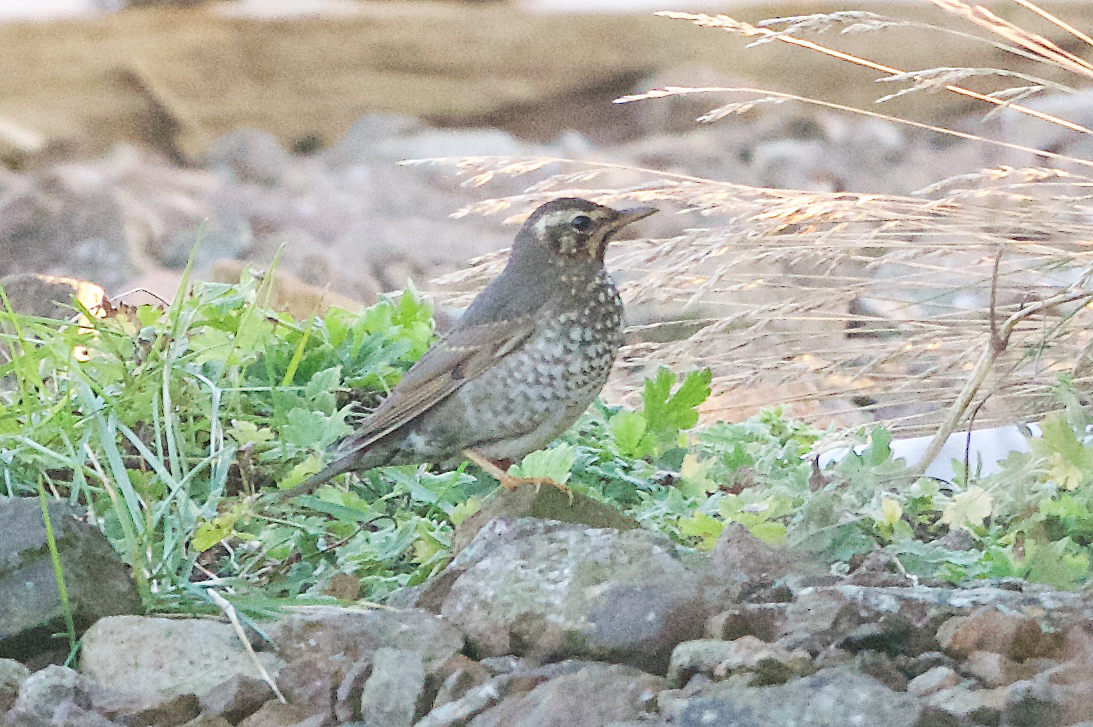
A finders account by one of this year’s clients, Anthony Griffiths who had chosen this year to be his first year to experience Shetland in autumn…
I can’t remember a time when I wasn’t interested in natural history and Birding in particular. As the years have passed I have become more keen on seeing and even more so, in finding, rare birds.
I have long dreamed of visiting the fabled Shetland Isles, especially in October, to witness autumn migration at its best. This was the year that I managed it for the first time, but it certainly will not be the last.
I chose Shetland Nature to be my guides for this trip as I share the ethos of the company to group find birds by well organised searches of any suitable habitat across the islands rather than simply chasing after other peoples finds.
We had had an excellent start to our trip encountering several Shetland specialities including a fantastic Lanceolated and Blyths Reed Warblers on our first day.
We then had a ‘Thrushtastic’ afternoon on Fetlar with an amazing White’s and a very confiding Swainson’s Thrushes within a mile of each other!!
On the 6th October we were on Unst all day. We started at the valley of Norwick where there was a steady, significant movement of common thrushes and finches, (mostly Bramblings) streaming down the valley all morning along with Goldcrests in every bush, certainly a very promising start to the day!
We then spent an hour or so wading through the boggy fields below Norwick trying to flush the Great Snipe that had been present there for several days. We did flush a heavy bird with heavily marked underparts but had frustratingly brief views.
Sadly the day then went a little quiet, but only for a while! We dipped Common Rosefinch at Haroldswick and the long staying Hornemanns Arctic Redpoll at Clingera.
Looking for a bird to keep the day moving we headed to Uyeasound where a Barred Warbler had been reported as ‘showing well’, not a comment you hear relating to this species very often! When we arrived we met a birder who was just leaving who told us where it was last seen, it was sunbathing on a bush in one of the few large gardens in the Hamlet. Sadly, however, by the time we got there, of course there was no sign!
The group spread out to search for it and we were soon joined by 2 other teams of birders and there were soon around 15 of us searching the gardens and fields of Uyeasound. After about 1/2 hour we were starting to feel that we had missed our chance. I had been chatting with Howard Vaughan and David Bradnum, 2 members of a team that we had already bumped into several times during the week. We had just started to spread out again when a moderate sized thrush shot past first Howard and then myself and we could immediately see the unmistakable black and white underwing of a thrush of Siberian origin which instantly set the adrenaline flowing as any member of this group would be a superb find on Shetland, or anywhere in the UK for that matter!
Howard initially shouted “Whites!!!!’ as he had seen the spotted underparts but something didn’t feel right as the bird wasn’t big enough. It then flew directly over David and a few others where it briefly alighted on a tree and they could clearly see the very bold eye stripe and the shouts from the side of the house were very loud and very clear, ‘SIBERIAN, its definitely a SIBERIAN!!!!’
The bird then rocketed back round the house, back over Howard and myself across a small field and dived into a large Rosa bush in a very small back garden of a terrace house by the harbour.
I had, fortunately, unclipped my Camera and managed to fire off a series of shots as it flew across the field, more in hope than expectation, that I would capture any usable shots but I was delighted to review them once the bird had taken refuge in the Rosa and see that, although they were never going win any prizes, I had somehow managed to get a few shots that were able to confirm the identification. The black and white underwing pattern was clear, as was the very bold supercilium and it was also possible to see the dark blue upperparts indicating that the bird was a first winter male.
-
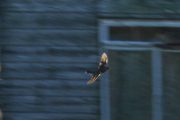
-
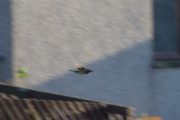
Once all the birders in our group and the other ‘teams’ had gathered, at a reasonable distance from the garden, our first aim was to get the news out to allow the other birders on Unst to connect with ‘our’ bird. As there was only about an hours light left it was going to be very difficult for anybody not already on Unst to connect that night. The main problem was that nobody had any mobile reception, fortunately though somebody managed to jump onto a local wifi connection and the news was out! The grape vine obviously went into full flow as it was only a few minutes before cars started to speed into the Hamlet with birders pouring out well before the wheels had stopped!
After a short while of staking out the garden it popped up onto the fence for just long enough for me to take a couple of shots before it flew out of the garden and out over the bay at, which time we thought it would carry on and be lost but it obviously thought better of it and did a turn and shot back into its new favourite garden, promptly vanishing back into the Rosa. It soon came out again and landed in view by the large warehouse where some of our group managed much better shots than I had managed of the bird on the ground in full view, these were the real ‘money’ shots showing all the salient identification features ( apart from ‘that’ underwing!)
It continued to show on and off in ‘its’ garden for all up until dusk.
We hung around for a while, getting more views of the bird and just generally soaking up the atmosphere of being part of the finding of such rare bird. This (assuming it is accepted) was only be the 10th record for the British isles!
It is such a great feeling to be able to see the anxious faces of red faced birders running to the site turn into huge grins as they catch that first sight of a new bird.
What an incredible end to yet another magnificent day on Shetland, Gary Drove us back to our accommodation, the bus was a mix of stunned silence and euphoria.
Once back at the hotel we soon found ourselves in the bar, toasting the day with a pint or 2 of the local brew!
Sadly there was no sign the following morning, we reckoned that somewhere around 50 birders managed to see the Thrush on that Thursday evening.
Many thanks to the great organization of Shetland nature, our excellent guide ( Gary Bell) and to whoever managed to arrange for such productive Siberian Easterly airflow for the whole of our trip, continuing for the whole of October resulting it what must surely go down as one of the best Octobers for Eastern rarities on record. Not a bad year to pick for my first trip to Shetland, and to coin a phrase…….I’ll be back!
Anthony Griffiths
Permalink
1st winter male Pine Bunting, Baltasound, Unst, Shetland 30/10/16
Posted by Brydon Thomason on Monday 21st November 2016 | Birding in Shetland
The family stroll that produced a Pine Bunting
Birding life in Shetland can be intensely emotive. If ‘find listing’ is your thing it can be even more so and as clichéd as it is to say it, the latter is often a rollercoaster ride of highs and lows, sometimes with unforgettable ‘purple patches’ but also those prefer-to-be forgotten pathetic ones. For myself and my usual bird finding buddies the October of all Octobers had yielded frustratingly little for us whilst absolutely crippling vagrants were being found the length and breadth of Shetland. No matter how hard we worked It simply was not our time.
The finding of a superb Siberian Accentor on Fetlar with Micky Maher and Stef McElwee on the 26th was indeed quite the turning point. In fact several days before that a delightful Pallas’s Warbler was the beginnings of the change for us…
Sunday 30th October was a coolish overcast and dull day, which had followed a calm, slack-weather night changing to light ESE winds. It was to be a day for the family, hanging up Halloween decorations, games and so on but after a nice relaxed family breakfast my usual morning circuit of the Halligarth trees had to be done! Finding a Dusky Warbler was a nice surprise, it even ended up in our garden too. My little bubble was soon to burst however when I went in to put the news out only to read; ‘Feas Petrel north past Lambaness’ on my mobile’s screen from Dave Cooper!!
After lunch I had made a plan with my wife Vaila that I’d take the bairn’s Casey (7), Corey (5) and Nula May (just four months old) in her pram for a circuit round central Baltasound. Barely 15 minutes along the road as we crossed the small area of waste ground between the terrace, junction and play park a fairly large bunting rose from the footpath. It was instantly recognisable as ‘hammer/pine’ by its long tailed and rusty rumped appearance. Even in this first flight view my attention was drawn to its contrasty/cold grey, dark and white head pattern. This looked VERY good!
Pine Bunting is on the radar in any Shetland autumn in late October/early November with easterlies but with it being a record year for them, none more so than this. It had flushed from our left, from about 20 yards away, across the road and landed atop of some alder branches about 50 to 60 yards away. Back on, I could see its head pattern well, again standing out was dark crown stripes, broad, cold greyish-white super (especially behind eye), dark ear covert surround with contrasting white oval shaped crescent to lower rear- my first view impulse ID was again concluded, a male PUNTING BUNTING!!
In normal ‘in the field’ circumstances the situation would be intense enough but here was I stood with our two sons and Nula in the pram! EE network, surprise-surprise was down so I had no signal but was literally in shouting distance from Mike Pennington’s house where I knew he and Micky Maher had just arrived. Choices: Stay watching the bird and try to nail it; leg it, pram and kids in tow along the road the 100 or so yards to get them risking losing the bird or hang on a minute- send Casey!
Casey, already excited enough to have seen it in the first place was briefed about the importance of getting Micky and Mike and he was to tell them “Dad’s found a rare bird!” To my shock as Casey was nearing Mikes driveway, Mikes car pulled out and turned the opposite way before Casey could reach them!! I had no choice really, I watched the bird for a short while till it moved further into the Post Office garden before legging it along the road to Mikes.
I couldn’t pursue the bird where it appeared to have gone (due to pram and bairn’s) and I obviously didn’t have a camera, nor could I say with 100% certainty that there was no trace of yellow on underparts. I’m lucky enough to have found Pine Bunting before, a cracking female (with Mike in November 2011) and remembered well the importance of ruling out potential hybrids. Where easternmost Yellowhammers meet with the westernmost Pine Buntings, hybridization is renowned and more importantly, such birds have been recorded in Britain. Even 2nd or 3rd generation birds can show traces of yellow such as fringing to tertials, primaries or underwing coverts- basically if it shows any of these it’s game over, you’ve found an intergrade.
Thankfully Margaret, Mikes wife was home and was an absolute star as always, she took the bairn’s in whilst I got Mike and Micky as well as calling Vaila to come with my camera. Soon after, now armed with camera, we relocated the bird in a sycamore next to Mikes house and together were able to nail it, getting good views (despite the showers!) and eliminate any possible sign of Yellowhammer genes and help nail it- he was as I first thought, 100% Pine!
Fellow Unst Birders Robbie Brookes, Dave Cooper and Brenda Kay were soon with us, although light was fading and showers were moving in we enjoyed superb views as it fed along roadsides, occasionally dropping into rank grassy fields for short periods. Finding good birds is always all the more memorable with your mates but finding them when you are out with the family is particularly special, some even might say spawny! We had great banter as we all congratulated Dave on his Fea’s and I jested how crazy but typical of this epic an autumn it was that the Pine Bunting wasn’t even bird of the day!
Permalink
Fetlar’s Siberian Accentor finders account
Posted by Brydon Thomason on Tuesday 8th November 2016 | Birding in Shetland
Brydon Thomason, Micky Maher & Stef McElwee
1) Taken from the yard it ended up and looking out over the field we found it in, showing the ditch it came out of and the area to left where it foraged around in marshy area of rank grass. 2) The all important and only image we got of ours and; 3) the very obliging Lund Siberian Accentor, which stayed another two days longer than ours.
“Just wait till our one on Fetlar- maybe Weds/Thursday??” These were BHT’s exact words in an email to MAM on the evening of 23rd October about the Lund Siberian Accentor. Both had been genuinely thrilled for Dave Cooper for such a superb and well deserved find and had enjoyed a good old bit of congratulatory banter with him. As it was on Unst however there was the inevitable, all be it fleeting thoughts of ‘if only’ and that their chance to cash in on the Accentor extravaganza had been missed.
Fast forward to 26th when BHT and MAM teamed up with SJM, for a day’s birding on Fetlar. On the ferry over there was at least some effort made to manage our expectations to a realistic level. Ten minutes on the island however, having started at South Dale, off-the-wall predictions from the far east were already flying out thick and fast.
As we approached the main croft and yard of South Dale, SJM enthusiastically hit us with “Lads, do you know the one ‘Sibe’ we haven’t actually mentioned today but should be thinking? Siberian Accentor!” To which BHT replied “You know what, after seeing the Lund bird I actually had a feeling for that very species at the very croft we are approaching, thinking Fetlar could easily have one and that’s where it could be”!
As we laughed it off two buntings rose from the roadside verge and flew a short way into an ungrazed field. One landed on the fence, clearly a Reed but the second bird had not been seen, having landed in the rank grasses. We detoured into and across the field- alas a second Reed rose from cover and landed on the fence. We continued through the small field, following a shallow ditch towards the intended cover of the yard where nettles, reed canary grass and dockings awaited…
Seconds later and barely three or four minutes after the ‘Sibe Acc’ banter, from our feet rose a small passerine that was bizarrely familiar to us. It landed in the grass no more than 20 metres away but due to length of grass, we could see no more than its head- baring the crippling crown streaks and ear coverts of a species that this October has become so very familiar to us and fellow birders and rarity hunters all over Europe. It was a brief and tantalising view before it scurried out of sight between tussocks of grass- this was it, mega time- we were most definitely in!!!
We attempted to counsel each other as we stalked cautiously to one side in order to get a better view- and there it was, creeping around between tussocks of grass, in the middle of a random marshy field- a SIBERIAN ACCENTOR!! It was a surreal and overwhelmingly knee trembling moment as the three of us stood side by side totally stunned, almost in disbelief that there right in front of us in the field we had just walked through because of two Reed Buntings- was ‘our’ very own Sibe Acc!!!
The immediate expletives and outbursts are, as one might expect under the circumstances, perhaps best left unpublished! MAM was the first to think quickly and keep it together enough to mention to rule out Black-throated.
Further shimmying to get that final 100% certainty view culminated in a joint feeling of adrenalin fuelled euphoria that If we could have bottled up to sell we would be very rich men! We punched the air, struck high fives and lost control in a celebratory huddle-group jump around; for a brief moment completely unaware of how our outbursts might affect our newly found Siberian Prunella or look to passersby!
We tried so desperately to keep it together though not one of us able to curb the frenzied state we felt. We were only a few hundred yards from the car, where sat all three of our cameras! BHT sprinted across the fields, returning with even more haste.
Perhaps not surprisingly given the commotion, we worked the area but to no avail. A wider search saw BHT discover it just 50 or so yards away in the more likely habitat of lush nettles and dockings grown up around an old midden of the yard. It flicked up posing nicely on a docking stem, more or less in full view but in typical docking stem/stand style, the auto focus jumped from stem to stem for a brief second before picking up the Acc- one in-focus frame and it flit back down into cover. This single photograph of the bird was to prove to be priceless- no other images were taken.
As we gathered around the area of cover in the yard by the old midden, we briefly ogled the single image nailed, again celebrated with gratuitous high fiving and back slaps, then moved cautiously closer. We presumed that like the other four Sibe Acc’s we’d seen between us already in the previous days/weeks that it would show intermittently as it scurried around amongst cover and show well at times- to our shock however, this was not to be the case! It flew out from the nettles but instead of darting into adjacent cover or perching, it flew off strongly and quite high northwards towards the next croft. It continued several hundred yards before seemingly descending towards it. That, unfortunately was the last we were to see of it despite pretty intense searching of any suitable nearby habitat.
There are so many elements that come together and make the discovery of rare birds so special and for none more so than the finders. It may be how rare the bird actually is; the chain of events or circumstances which led to it; how hard it was worked for or any number of others- maybe even the location or who you are with and the team spirited effort involved. For us and in this instance it was all these and especially the latter. We couldn’t have picked a better crew nor island to find it on.
Up to the date this was posted a staggering 212 Siberian Accentors had been recorded in Europe, 12 of which in Britain, ours being the 10th. It is widely expected that more will be added to this monumental figure. Quite a winter target bird for your local patch perhaps?
An interesting extract from Dutch Birding; Siberian Accentor breeds on both sides of the Ural mountains and beyond in Siberia, mostly north of the Arctic Circle. Its winter grounds are in eastern Asia: from southern Manchuria, Korea and Japan to central China. In autumn, it is also frequently recorded as a straggler in Alaska, USA. In Europe, there were c 32 records up to 2015, of which more than half in Finland and Sweden.
Permalink
Shetland 2015: Autumn Birding Review – In association with Birdwatch Magazine
Posted by Brydon Thomason on Monday 16th November 2015 | Birding in Shetland, News
As Shetland becomes ever more popular in autumn, high expectations hang over the magical Northern Isles for what the winds may bring. So well placed is the archipelago that even without favourable wind and weather the isles will usually still manage to deliver. This year’s prime-time weeks in late September and early October were a classic example of this.
These migrant birding holidays always begin with optimism and anticipation and indeed with the Quendale Thick-Billed Warbler (successfully twitched with a guest from a previous tour) and then finding a nice Blyth’s Reed Warbler the day before the trips began, leader Chris Rodger knew anything was possible, despite a not-so-promising long-term forecast.
In a systematic ‘trip-list style summary’ he rounds up the highlights.
Highlights
- National rarities: Swainson’s Thrush, Pechora Pipit, Pallid Harrier and Arctic Warbler.
- Regional rarities: Blyth’s Reed Warbler, American Golden Plover.
- Scarcities: Red-breasted Flycatcher, Red-backed and Great Grey Shrikes, Little Bunting, Common Rosefinch and Bluethroat.
- Self-found by the group: Richard’s Pipit, Bluethroat and numerous Yellow-browed Warblers.
Wildfowl
The evocative sight and sound of Whooper Swans arriving from Iceland was a regular feature, along with migratory movement of many Pink-footed and Barnacle Geese overhead on their journey south. On the sea, Long-tailed Duck numbers seemed to swell by the day, with Velvet Scoter and Slavonian Grebe also enjoyed. In addition to the many Red-throated Divers, some Great Northern Divers still retained stunning summer plumage. A fine drake Greater Scaup was seen at Loch of Norby.
Raptors (and owls)
Undoubtedly the star bird of prey was the juvenile Pallid Harrier, seen coming to roost at Northdale, Unst. Hen Harrier, Peregrine and Short-eared Owl were less frequent than the many migrant Kestrels, Sparrowhawks and Merlins, which were particularly numerous this autumn.
Waders to doves
As is true to form on previous Shetland autumn birding trips, Nearctic waders were sure to feature and this year came in the form of a ‘classic’ juvenile American Golden Plover, which really stood out among the European ‘Goldies’ at Sandwick. Many Jack Snipe were seen – mostly rising from marshes and often almost from underfoot, but some particularly obliging birds at Lambaness froze to the spot to show at close range their beautiful cryptic plumage. A smattering of migrant waders included Ruff, Black-tailed Godwit, Grey Plover, Knot, a late Eurasian Whimbrel and the always ubiquitous and subtly different ‘Icelandic’ (faeroeensis) Snipe. White-winged gulls were incredibly scarce this year on Shetland, though Arctic Terns and one Common Tern lingered for the group to see. An adult European Turtle Dove at Haroldswick was well scrutinised to eliminate meena Oriental Turtle Dove.
Pipits to thrushes
A self-found Richard’s Pipit at Lambaness was a highlight for the group, schreeping for Scotland as it bounded across Lambaness and a good example of quality scarce migrants that feature as team self-finds to add that extra gratification. This was the first of several seen. A ‘tiger-striped’ Pechora Pipit, twitched at Norby, eventually yielded to give excellent views as it crept through the irises. A combination of its genuine rarity value, Shetland speciality status and confiding nature ensured this was a firm favourite of the week. Braving gale force wind and rain on Unst, a female Yellow Wagtail was found by the group as was a Bluethroat, discovered hunkered down in a ditch at Burrafirth – if ever proving that ‘you have to be in it to win it’, no matter what the weather! Another fine Bluethroat was enjoyed feeding at close quarters at Quendale.
Undoubtedly a highlight came in the form of a Swainson’s Thrush on Unst – a superb end to the first full day of the trip. After a mad dash from literally the opposite end of Shetland, the group had to endure perhaps the most suspenseful wait in fading light for the bird to hop out from under some fishery crates in the yard of a shop! Hop out it did, revealing the lovely buff face and eyering and subtle underparts spotting, and it even gave a close fly-by to show off its underwing stripe. This was a tick for all bar one of the group, who also saw one with our Shetland Nature autumn birding group on Unst last year!
Warblers and crests
Perhaps the group that forms the major attraction for rarity-hunters on Shetland, warblers – a common and rare alike – were relatively thin on the ground this autumn. Despite this, the group did see a Blyth’s Reed Warbler (which had been found by Chris the day before the trip started) and several Barred Warblers. An Arctic Warbler was a rarer highlight; the group missed this bird on Unst, when it disappeared on the day it lost its tail. However, we caught up with what must surely have been the same bird several days later when a tail-less Arctic Warbler was found in central Mainland. To be fair, Yellow-browed Warblers didn’t disappoint this autumn – amazingly by far the most frequent warbler, but very much still a joy to see. As ever, the Shetland autumn trip allowed the comparison of side-by-side Common and Siberian Chiffchaffs. A personal favourite were the mornings when Shetland is seemingly awash with tiny Goldcrests – mass landfall of these wee 5-gram waifs signal ‘birds in!’.
Flycatchers to buntings
Both groups enjoyed three species of flycatcher, including some very confiding, and always photogenic, Red-breasted Flycatchers. Both Red-backed and Great Grey Shrikes were seen on Unst. Of the finches, Bramblings added colour while redpolls, although surprisingly scarce in the islands this autumn, encouraged ID discussion. A most impressive sight was a flock of 200 very confiding Snow Buntings, swirling all around us like an avian snowstorm on the wild windswept headland of Lambaness. A scarcity that we can usually look forward to throughout the Shetland is Common Rosefinch, which this year was hard won but eventually added to the trip list, unlike a Lapland Bunting which fed virtually at our feet. Of the scarcer buntings, a nice bright Little Bunting on Fetlar was timed well, found by fellow SN team members Micky and Brydon on the same day we were all on the isle. Perhaps a commoner example of the many Shetland scarcities to end on, but it does leave tantalising thoughts for what the review might start with for next year’s Shetland Autumn Birding trips!
Chris Rodger
Permalink









